Hybrid Fiber Optic Sensor Systems in Structural Health Monitoring in Aircraft Structures
Abstract
1. Introduction
2. Hybrid Sensors Based on FBG
3. Hybrid Interferometric Sensors
4. Polarimetric Sensors
5. Hybrid Sensors Based on Scattering Techniques
6. Constraints Imposed by Composites on Aircraft
- (1)
- Weight sensitivity: The system must add a minimum amount of weight. A life-cycle calculation can be made to compare the obligatory replacement of a component after a certain number of flight hours with the addition of an instrumented component which has higher weight and cost.
- (2)
- Thickness of structure: In most cases the thickness ranges between 0.5 to 3 mm (there are portions as thick as 10 or 20 mm, but very few).
- (3)
- Aerodynamics: Nothing can be attached on the outside because it adversely affects aerodynamic performance and is subject to damage (e.g., hail damage, tool drops, runway debris, etc.)
- (4)
- Access: If the system must be accessed for service or other reasons, it can only be used at limited areas where access doors are already available for maintenance or inspection. Adding extra access doors adds to the cost and weight. At the same time, typical areas of concern are at joints and 3-D structural details which are typically deep inside the structure. Thus, access is limited, which means the system must be robust, redundant and must have a long life.
- (5)
- Entry-exit points of sensors: Given that sensors must be embedded, robust, and low cost, the entry and exit points must be used. Additionally, these must be low weight.
- (6)
- Ply thickness: Typical composite plies are 0.1–0.3 mm thick. If the sensors are of the same size, then they either locally disrupt the strain field they are trying to measure or may act as stress concentrations leading to local failure.
- (7)
- Environment: The system must withstand temperatures ranging from −50 to +75 °C, dry to fully saturated by humidity environments, and potential exposure to hydraulic fluids or jet fuel.
7. Conclusions
Author Contributions
Funding
Acknowledgments
Conflicts of Interest
References
- Safri, S.; Sultan, M.; Yidris, N.; Mustapha, F. Low Velocity and High Velocity Impact Test on Composite Materials—A review. Int. J. Eng. Sci. 2014, 3, 50–60. [Google Scholar]
- Gardner, R.D.; Andonovic, I.; Hunter, D.K.; McLaughlin, A.J.; Aitchison, J.S.; Marsh, J.H. PHONAV—A photonic WDM network architecture for next generation avionics systems. IEEE Aerosp. Appl. Conf. Proc. 1999, 2, 451–466. [Google Scholar]
- John, R.N. Impact Detection Techniques Using Fibre-Optic Sensors for Aerospace & Defence. Ph.D. Thesis, Heriot-Watt University, Edinburgh, UK, 2015. [Google Scholar]
- Yoon, H.J.; Song, K.Y.; Choi, C.; Na, H.S.; Kim, J.S. Real-time distributed strain monitoring of a railway bridge during train passage by using a distributed optical fiber sensor based on brillouin optical correlation domain analysis. J. Sens. 2016, 2016, 9137531. [Google Scholar] [CrossRef]
- Barrias, A.; Casas, J.R.; Villalba, S. A Review of Distributed Optical Fiber Sensors for Civil Engineering Applications. Sensors 2016, 16, 748. [Google Scholar] [CrossRef]
- Schenato, L. A review of distributed fibre optic sensors for geo-hydrological applications. Appl. Sci. 2017, 7, 896. [Google Scholar] [CrossRef]
- Galindez-Jamioy, C.A.; López-Higuera, J.M. Brillouin distributed fiber sensors: An overview and applications. J. Sens. 2012, 2012, 204121. [Google Scholar] [CrossRef]
- Majumder, M.; Gangopadhyay, T.K.; Chakraborty, A.K.; Dasgupta, K.; Bhattacharya, D.K. Fibre Bragg gratings in structural health monitoring-Present status and applications. Sens. Actuators A Phys. 2008, 147, 150–164. [Google Scholar] [CrossRef]
- Petuchowskl, S.J.; Giallorenzi, T.G.; Sheem, S.K. A Sensitive Fiber-Optic Fabry-Perot Interferometer. IEEE J. Quantum Electron. 1981, 17, 2168–2170. [Google Scholar] [CrossRef]
- Domański, A.W.; Bieda, M.; Lesiak, P.; Makowski, P.; Szela̧g, M.; Poczȩsny, T.; Prokopczuk, K.; Sobotka, P.; Chychłowski, M.; Sierakowski, M.; et al. Polarimetric optical fiber sensors for dynamic strain measurement in composite materials. Acta Phys. Pol. A 2013, 124, 399–401. [Google Scholar] [CrossRef]
- Noh, T.K.; Ryu, U.C.; Lee, Y.W. Compact and wide range polarimetric strain sensor based on polarization-maintaining photonic crystal fiber. Sens. Actuators A Phys. 2014, 213, 89–93. [Google Scholar] [CrossRef]
- Lesiak, P.; Szeląg, M.; Budaszewski, D.; Plaga, R.; Mileńko, K.; Rajan, G.; Semenova, Y.; Farrell, G.; Boczkowska, A.; Domański, A.; et al. Influence of lamination process on optical fiber sensors embedded in composite material. Meas. J. Int. Meas. Confed. 2012, 45, 2275–2280. [Google Scholar] [CrossRef]
- Braga, R.R.; Ferracane, J.L. Alternatives in polymerization contraction stress management. Crit. Rev. Oral Biol. Med. 2004, 15, 176–184. [Google Scholar] [CrossRef] [PubMed]
- Cavaleiro, P.M.; Araüjo, F.M.; Ferreira, L.A.; Santos, J.L.; Farahi, F. Simultaneous measurement of strain and temperature using Bragg gratings written in germanosilicate and boron-codoped germanosilicate fibers. IEEE Photonics Technol. Lett. 1999, 11, 1635–1637. [Google Scholar] [CrossRef]
- Kuang, K.S.C.; Kenny, R.; Whelan, M.P.; Cantwell, W.J.; Chalker, P.R. Embedded fibre Bragg grating sensors in advanced composite materials. Compos. Sci. Technol. 2001, 61, 1379–1387. [Google Scholar] [CrossRef]
- Shu, X.; Liu, Y.; Zhao, D.; Gwandu, B.; Floreani, F.; Zhang, L.; Bennion, I. Dependence of temperature and strain coefficients on fiber grating type and its application to simultaneous temperature and strain measurement. Opt. Lett. 2002, 27, 701–703. [Google Scholar] [CrossRef]
- Chen, G.; Liu, L.; Jia, H.; Yu, J.; Xu, L.; Wang, W. Simultaneous strain and temperature measurements with fiber Bragg grating written in novel Hi-Bi optical fiber. IEEE Photonics Technol. Lett. 2004, 16, 221–223. [Google Scholar] [CrossRef]
- Zhou, D.P.; Wei, L.; Liu, W.K.; Lit, J.W.Y. Simultaneous strain and temperature measurement with fiber Bragg grating and multimode fibers using an intensity-based interrogation method. IEEE Photonics Technol. Lett. 2009, 21, 468–470. [Google Scholar] [CrossRef]
- Rajan, G.; Ramakrishnan, M.; Semenova, Y.; Milenko, K.; Lesiak, P.; Domanski, A.W.; Wolinski, T.R.; Farrell, G. A photonic crystal fiber and fiber Bragg grating-based hybrid fiber-optic sensor system. IEEE Sens. J. 2012, 12, 39–43. [Google Scholar] [CrossRef]
- Sonnenfeld, C.; Sulejmani, S.; Geernaert, T.; Eve, S.; Lammens, N.; Luyckx, G.; Voet, E.; Degrieck, J.; Urbanczyk, W.; Mergo, P.; et al. Microstructured optical fiber sensors embedded in a laminate composite for smart material applications. Sensors 2011, 11, 2566–2579. [Google Scholar] [CrossRef]
- Luyckx, G.; Voet, E.; Geernaert, T.; Chah, K.; Nasilowski, T.; De Waele, W.; Van Paepegem, W.; Becker, M.; Bartelt, H.; Urbanczyk, W.; et al. Response of FBGs in microstructured and bow tie fibers embedded in laminated composite. IEEE Photonics Technol. Lett. 2009, 21, 1290–1292. [Google Scholar] [CrossRef]
- Guemes, J.A.; Menéndez, J.M. Response of Bragg grating fiber-optic sensors when embedded in composite laminates. Compos. Sci. Technol. 2002, 62, 959–966. [Google Scholar] [CrossRef]
- Montanini, R.; D’Acquisto, L. Simultaneous measurement of temperature and strain in glass fiber/epoxy composites by embedded fiber optic sensors: II. Post-cure testing. Smart Mater. Struct. 2007, 16, 1727–1735. [Google Scholar] [CrossRef]
- Patrick, H.J.; Williams, G.M.; Kersey, A.D.; Pedrazzani, J.R.; Vengsarkar, A.M. Hybrid fiber Bragg grating/long period fiber grating sensor for strain/temperature discrimination. IEEE Photonics Technol. Lett. 1996, 8, 1223–1225. [Google Scholar] [CrossRef]
- Rao, Y.J.; Yuan, S.F.; Zeng, X.K.; Lian, D.K.; Zhu, Y.; Wang, Y.P.; Huang, S.L.; Liu, T.Y.; Fernando, G.F.; Zhang, L.; et al. Simultaneous strain and temperature measurement of advanced 3-D braided composite materials using an improved EFPI/FBG system. Opt. Lasers Eng. 2002, 38, 557–566. [Google Scholar] [CrossRef]
- Kang, H.K.; Kang, D.H.; Hong, C.S.; Kim, C.G. Simultaneous monitoring of strain and temperature during and after cure of unsymmetric composite laminate using fibre-optic sensors. Smart Mater. Struct. 2003, 12, 29–35. [Google Scholar] [CrossRef]
- Güemes, A.; Fernández-López, A.; Díaz-Maroto, P.F.; Lozano, A.; Sierra-Perez, J. Structural health monitoring in composite structures by fiber-optic sensors. Sensors 2018, 18, 1094. [Google Scholar] [CrossRef]
- Guo, H.; Xiao, G.; Mrad, N.; Yao, J. Fiber optic sensors for structural health monitoring of air platforms. Sensors 2011, 11, 3687–3705. [Google Scholar] [CrossRef]
- Lamb, H. On Waves in an Elastic Plate. Proc. R. Soc. A Math. Phys. Eng. Sci. 1917, 93, 114–128. [Google Scholar]
- Worlton, D.C. Ultrasonic testing with Lamb waves. Nondestruct. Test. 1957, 15, 218–222. [Google Scholar]
- Ogisu, T.; Shimanuki, M.; Kiyoshima, S.; Okabe, Y.; Takeda, N. Feasibility studies on active damage detection for CFRP aircraft bonding structures. Adv. Compos. Mater. Off. J. Jpn. Soc. Compos. Mater. 2006, 15, 153–173. [Google Scholar] [CrossRef]
- Qing, X.; Kumar, A.; Zhang, C.; Gonzalez, I.F.; Guo, G.; Chang, F.K. A hybrid piezoelectric/fiber optic diagnostic system for structural health monitoring. Smart Mater. Struct. 2005, 14, S98. [Google Scholar] [CrossRef]
- Tsuda, H. Ultrasound and damage detection in CFRP using fiber Bragg grating sensors. Compos. Sci. Technol. 2006, 66, 676–683. [Google Scholar] [CrossRef]
- Lam, P.M.; Lau, K.T.; Ling, H.Y.; Su, Z.; Tam, H.Y. Acousto-ultrasonic sensing for delaminated GFRP composites using an embedded FBG sensor. Opt. Lasers Eng. 2009, 47, 1049–1055. [Google Scholar] [CrossRef]
- Tan, Y.; Cai, L.; Peng, B.; Meng, L. An investigation of structural damage location based on ultrasonic excitation-fiber bragg grating detection. Adv. Acoust. Vib. 2013, 2013, 525603. [Google Scholar] [CrossRef]
- Barazanchy, D.; Martinez, M.; Rocha, B.; Yanishevsky, M. A hybrid structural health monitoring system for the detection and localization of damage in composite structures. J. Sens. 2014, 2014, 109403. [Google Scholar] [CrossRef]
- Rocha, B.; Barazanchy, D.; Sevenois, R.; Guo, H.; Xiao, G.; Mrad, N. Assessment of fibre optic sensor architectures for structural health monitoring. In Proceedings of the IWSHM 2013-International Workshop on Structural Health Monitoring-2013 “A Roadmap to Intelligent Structures”, Dohrmann Grove, Stanford University, Stanford, CA, USA, 10–12 September 2013; Volume 1, pp. 470–477. [Google Scholar]
- Rao, C.; Duan, L. Bidirectional, bimodal ultrasonic lamb wave sensing in a composite plate using a polarization-maintaining fiber bragg grating. Sensors 2019, 19, 1375. [Google Scholar] [CrossRef] [PubMed]
- Feng, Q.; Tang, M.; Ou, J. Monolithic multicore fiber based multi-parameter measurement based on spatial-division-multiplex sensing mechanisms. Measurement 2020, 151, 107128. [Google Scholar] [CrossRef]
- Sbarufatti, C.; Beligni, A.; Gilioli, A.; Ferrario, M.; Mattarei, M.; Martinelli, M.; Giglio, M. Strain wave acquisition by a fiber optic coherent sensor for impact monitoring. Materials 2017, 10, 794. [Google Scholar] [CrossRef]
- Djinovic, Z.; Tomic, M.; Stojkovic, M.; Schmid, G. Failure detection by a fiber optic low coherence interferometric sensor. In Proceedings of the 5th European Workshop on Structural Health Monitoring, Sorrento, Italy, 29 June–4 July 2010; pp. 609–614. [Google Scholar]
- Djinovic, Z.; Stojkovic, M.; Tomic, M. Online structural health monitoring of wire rope by fiber optic low coherence interferometric sensor. In Proceedings of the 6th European Workshop on Structural Health Monitoring, Dresden, Germany, 3–6 July 2012; Volume 2, pp. 1479–1488. [Google Scholar]
- Akhavan, F.; Watkins, S.E.; Chandrashekhara, K. Hybrid sensors for impact-induced strain in smart composite plates. In Proceedings of the Smart Structures and Materials 1995: Smart Sensing, Processing, and Instrumentation, San Diego, CA, USA, 26 February–3 March 1995; Spillman, W.B.J., Ed.; Volume 2444, pp. 514–525. [Google Scholar]
- Udd, E. Embedded Sensors Make Structures “Smart”. Laser Focus 1988, 24, 135–139. [Google Scholar]
- Ramakrishnan, M.; Rajan, G.; Semenova, Y.; Lesiak, P.; Domanski, A.; Wolinski, T.; Boczkowska, A.; Farrell, G. The influence of thermal expansion of a composite material on embedded polarimetric sensors. Smart Mater. Struct. 2011, 20, 125002. [Google Scholar] [CrossRef]
- Lesiak, P.; Rajan, G.; Semenova, Y.; Farrell, G.; Boczkowska, A.; Domański, A.; Woliński, T. A hybrid highly birefringent fiber optic sensing system for simultaneous strain and temperature measurement. Photonics Lett. Pol. 2010, 2, 140–142. [Google Scholar] [CrossRef]
- Lesiak, P.; Szeląg, M.; Awietjan, S.; Kuczkowski, M.; Ertman, S.; Budaszewski, D.; Domański, A.; Woliński, T. Influence of the lamination process on the plastic optical fiber sensors embedded in composite materials. In Proceedings of the 21st International Conference on Optical Fiber Sensors, Ottawa, Canada, 15–19 May 2011; Baldini, F., Homola, J., Lieberman, R.A., Eds.; Volume 7753, p. 877405. [Google Scholar]
- Lesiak, P.; Szostkiewicz, Ł.; Woliński, T.R. Numerical analysis of stress distribution in embedded polymer and silica-glass highly birefringent fibers. J. Light. Technol. 2016, 34, 4564–4571. [Google Scholar] [CrossRef]
- Di Sante, R. Fibre optic sensors for structural health monitoring of aircraft composite structures: Recent advances and applications. Sensors 2015, 15, 18666–18713. [Google Scholar] [CrossRef] [PubMed]
- Barnoski, M.K.; Jensen, S.M. Fiber waveguides: A novel technique for investigating attenuation characteristics. Appl. Opt. 1976, 15, 2112. [Google Scholar] [CrossRef]
- Alahbabi, M.N.; Cho, Y.T.; Newson, T.P. Simultaneous temperature and strain measurement with combined spontaneous Raman and Brillouin scattering. Opt. Lett. 2005, 30, 1276. [Google Scholar] [CrossRef]
- Alasia, D.; Gonzalez Herraez, M.; Abrardi, L.; Martin-Lopez, S.; Thevenaz, L. Detrimental effect of modulation instability on distributed optical fiber sensors using stimulated Brillouin scattering. In Proceedings of the 17th International Conference on Optical Fibre Sensors, Bruges, Belgium, 23–27 May 2005; Volume 5855, p. 587. [Google Scholar]
- Udd, E.; Spillman, W.B. Fiber Optic Sensors: An Introduction for Engineers and Scientists, 2nd ed.; John Wiley & Sons: Hoboken, NJ, USA, 2011; Volume 33, ISBN 9780470126844. [Google Scholar]
- Optical Fiber Sensor Technology; Grattan, K.T.V., Meggitt, B.T., Eds.; Springer US: Boston, MA, USA, 2000; ISBN 978-1-4419-4983-7. [Google Scholar]
- Bao, X.; Webb, D.J.; Jackson, D.A. 32-km distributed temperature sensor based on Brillouin loss in an optical fiber. Opt. Lett. 1993, 18, 1561. [Google Scholar] [CrossRef]
- Wait, P.C.; De Souza, K.; Newson, T.P. A theoretical comparison of spontaneous Raman and Brillouin based fibre optic distributed temperature sensors. Opt. Commun. 1997, 144, 17–23. [Google Scholar] [CrossRef][Green Version]
- Bolognini, G.; Soto, M.A.; Pasquale, F. Di Simultaneous distributed strain and temperature sensing based on combined Raman-Brillouin scattering using Fabry-Perot lasers. Meas. Sci. Technol. 2010, 21, 094025. [Google Scholar] [CrossRef]
- Zhang, J.; Zhu, T.; Zhou, H.; Huang, S.; Liu, M.; Huang, W. High spatial resolution distributed fiber system for multi-parameter sensing based on modulated pulses. Opt. Express 2016, 24, 27482. [Google Scholar] [CrossRef]
- Taki, M.; Signorini, A.; Oton, C.J.; Nannipieri, T.; Pasquale, F.D. Hybrid Raman/Brillouin-optical-time-domain-analysis-distributed optical fiber sensors based on cyclic pulse coding. Opt. Lett. 2013, 38, 4162. [Google Scholar] [CrossRef]
- Muanenda, Y.; Oton, C.J.; Faralli, S.; Nannipieri, T.; Signorini, A.; Pasquale, F. Di Hybrid distributed acoustic and temperature sensor using a commercial off-the-shelf DFB laser and direct detection. Opt. Lett. 2016, 41, 587. [Google Scholar] [CrossRef] [PubMed]
- Muanenda, Y.; Oton, C.J.; Faralli, S.; Nannipieri, T.; Signorini, A.; Di Pasquale, F. A distributed acoustic and temperature sensor using a commercial off-the-shelf DFB laser. In Proceedings of the 24th International Conference on Optical Fibre Sensors, Curitiba, Brazil, 28 September–2 October 2015; Volume 9634, p. 96342C. [Google Scholar]
- Ito, Y.; Minakuchi, S.; Mizutani, T.; Takeda, N. Cure monitoring of carbon-epoxy composites by optical fiber-based distributed strain-temperature sensing system. Adv. Compos. Mater. 2012, 21, 259–271. [Google Scholar] [CrossRef]
- Jothibasu, S.; Du, Y.; Anandan, S.; Dhaliwal, G.S.; Kaur, A.; Watkins, S.E.; Chandrashekhara, K.; Huang, J. Strain monitoring using distributed fiber optic sensors embedded in carbon fiber composites. In Proceedings of the Proc. SPIE, Sensors and Smart Structures Technologies for Civil, Mechanical, and Aerospace Systems 2018, Denver, CO, USA, 5–8 March 2018; p. 10598. [Google Scholar]
- Bang, H.J.; Jun, S.M.; Kim, C.G. Stabilized interrogation and multiplexing techniques for fibre Bragg grating vibration sensors. Meas. Sci. Technol. 2005, 16, 813–820. [Google Scholar] [CrossRef]
- Bremer, K.; Lewis, E.; Leen, G.; Moss, B.; Lochmann, S.; Mueller, I.A.R. Feedback stabilized interrogation technique for EFPI/FBG hybrid fiber-optic pressure and temperature sensors. IEEE Sens. J. 2012, 12, 133–138. [Google Scholar] [CrossRef]
- Díaz, C.A.R.; Leitão, C.; Marques, C.A.; Domingues, M.F.; Alberto, N.; Pontes, M.J.; Frizera, A.; Ribeiro, M.R.N.; André, P.S.B.; Antunes, P.F.C. Low-cost interrogation technique for dynamic measurements with FBG-based devices. Sensors 2017, 17, 2414. [Google Scholar] [CrossRef] [PubMed]
- Cui, J.; Hu, Y.; Feng, K.; Li, J.; Tan, J. FBG interrogation method with high resolution and response speed based on a reflective-matched FBG scheme. Sensors 2015, 15, 16516–16535. [Google Scholar] [CrossRef] [PubMed]
- Kaźmierczak, A.; Jusza, A.; Slowikowski, M.; Stopiński, S.; Piramidowicz, R. Integrated interrogator circuits for fiber optic sensor network in generic InP photonic integrated circuit technology. In Proceedings of the Optical Sensing and Detection V, Strasbourg, France, 23–26 April 2018; Berghmans, F., Mignani, A.G., Eds.; SPIE: Bellingham, WA, USA, 2018; p. 23. [Google Scholar]
- Kaźmierczak, A.; Stopiński, S.; Jusza, A.; Anders, K.; Piramidowicz, R. Sensing applications of photonic integrated circuits: Ultra-compact optical transducers and interrogators. In Proceedings of the 17th Conference on Optical Fibres and Their Applications 2017, Supraśl, Poland, 23–27 January 2017; Volume 10325, p. 103250A. [Google Scholar]
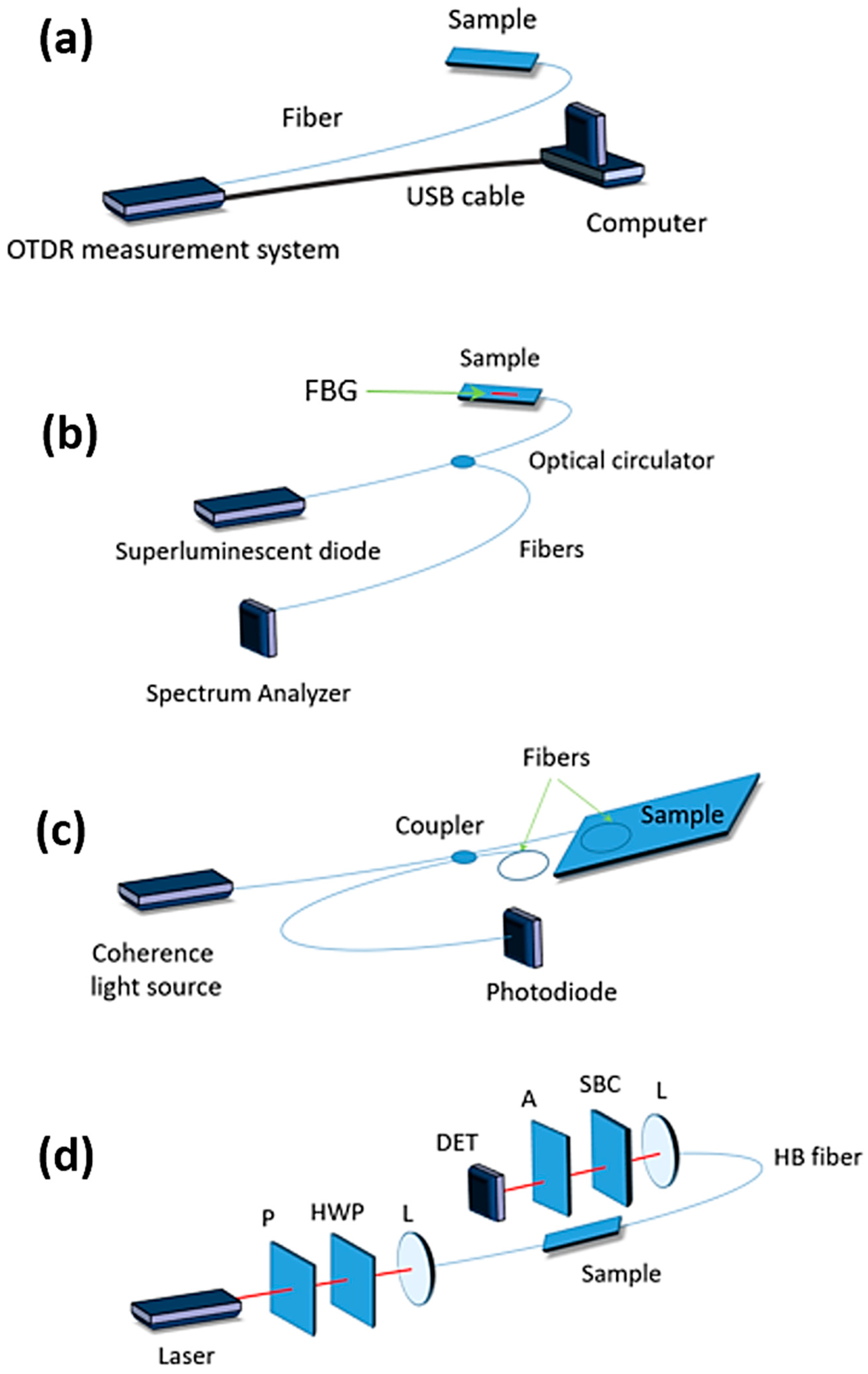
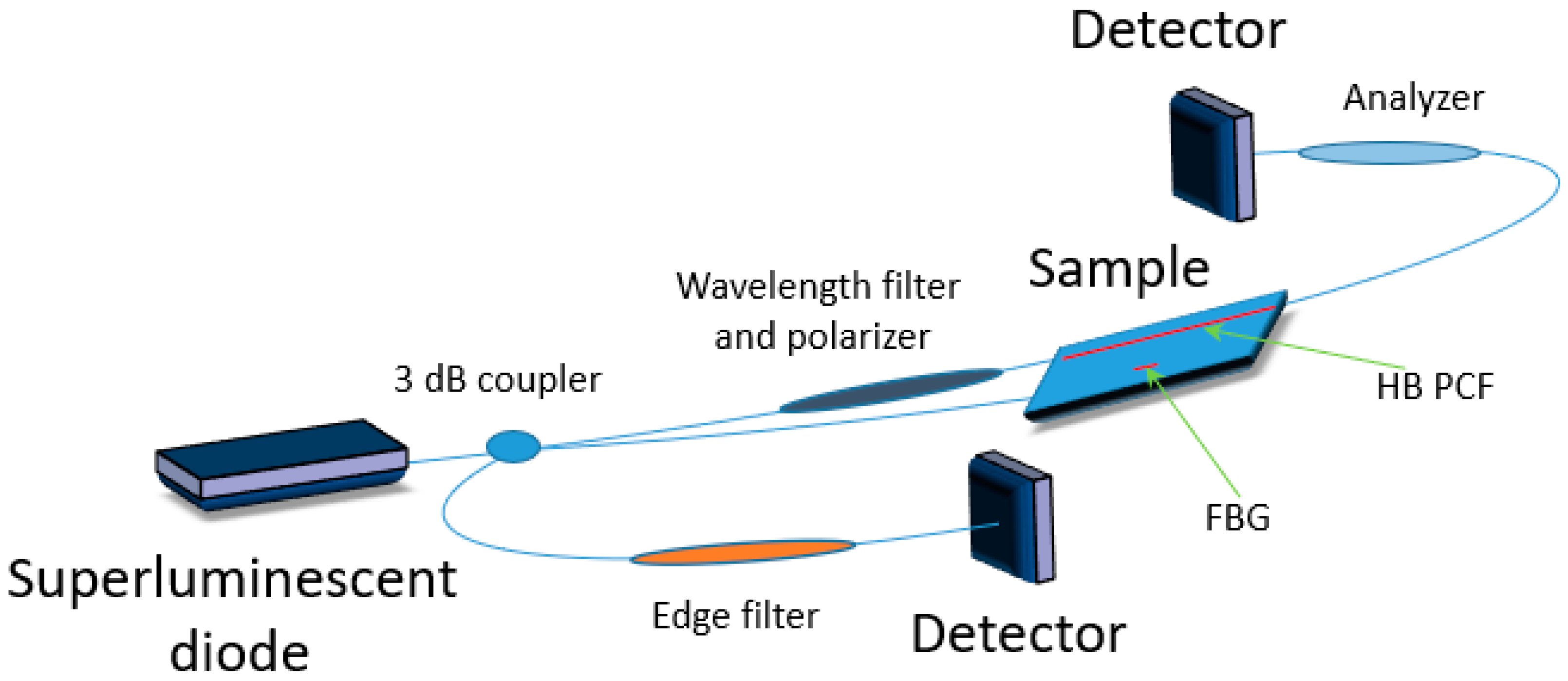


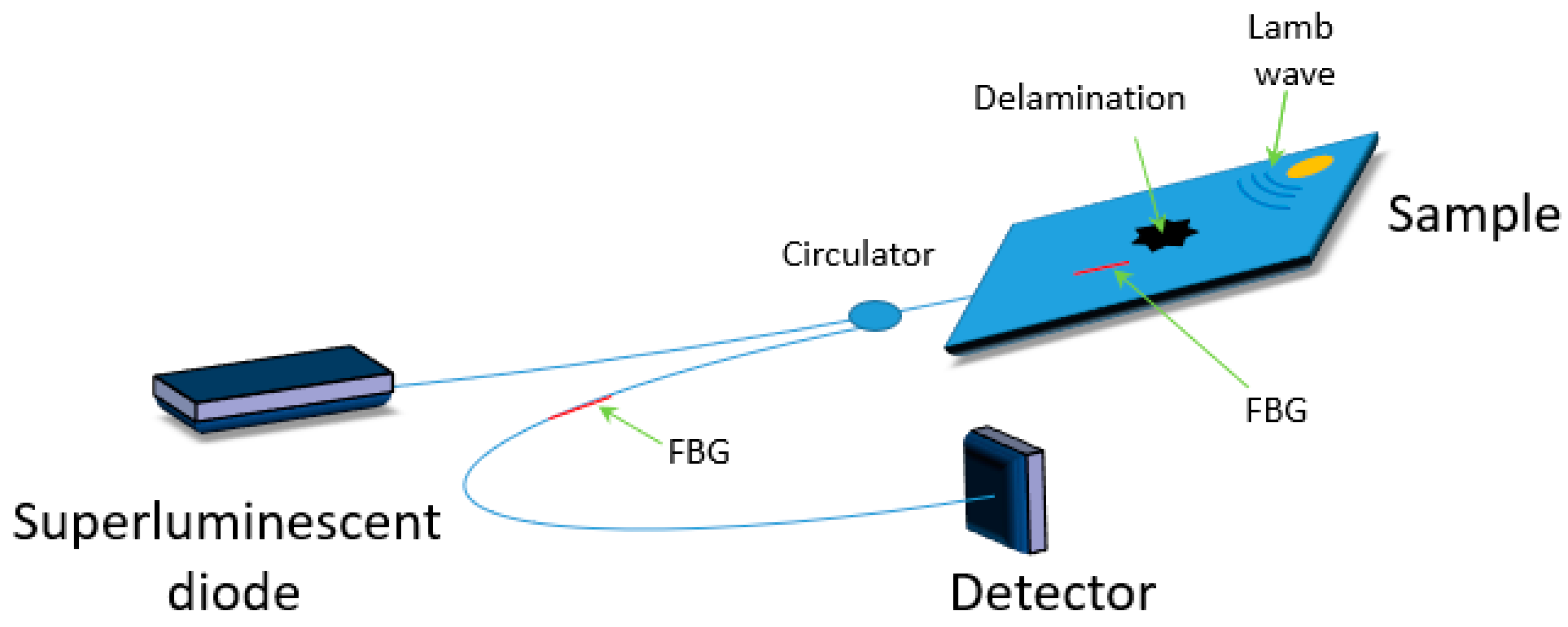
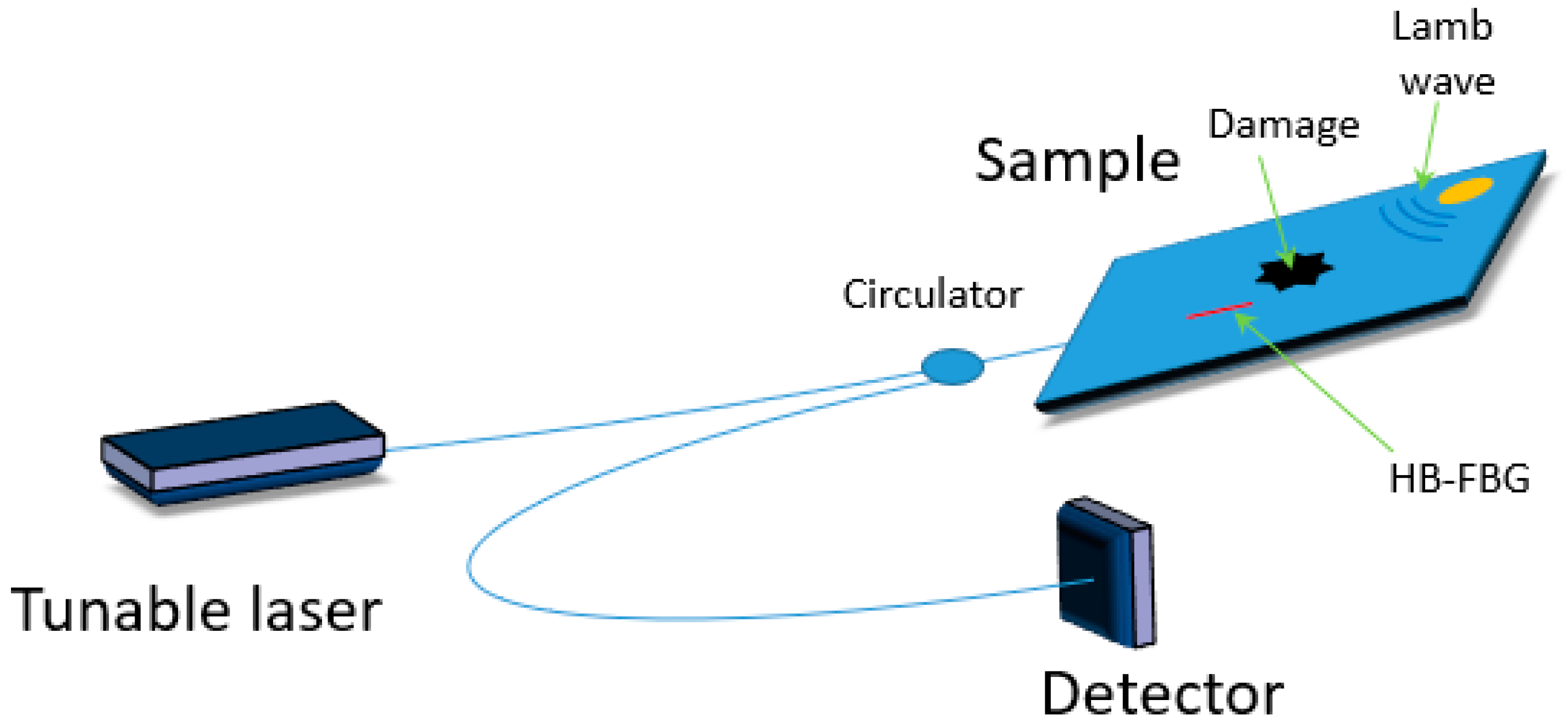
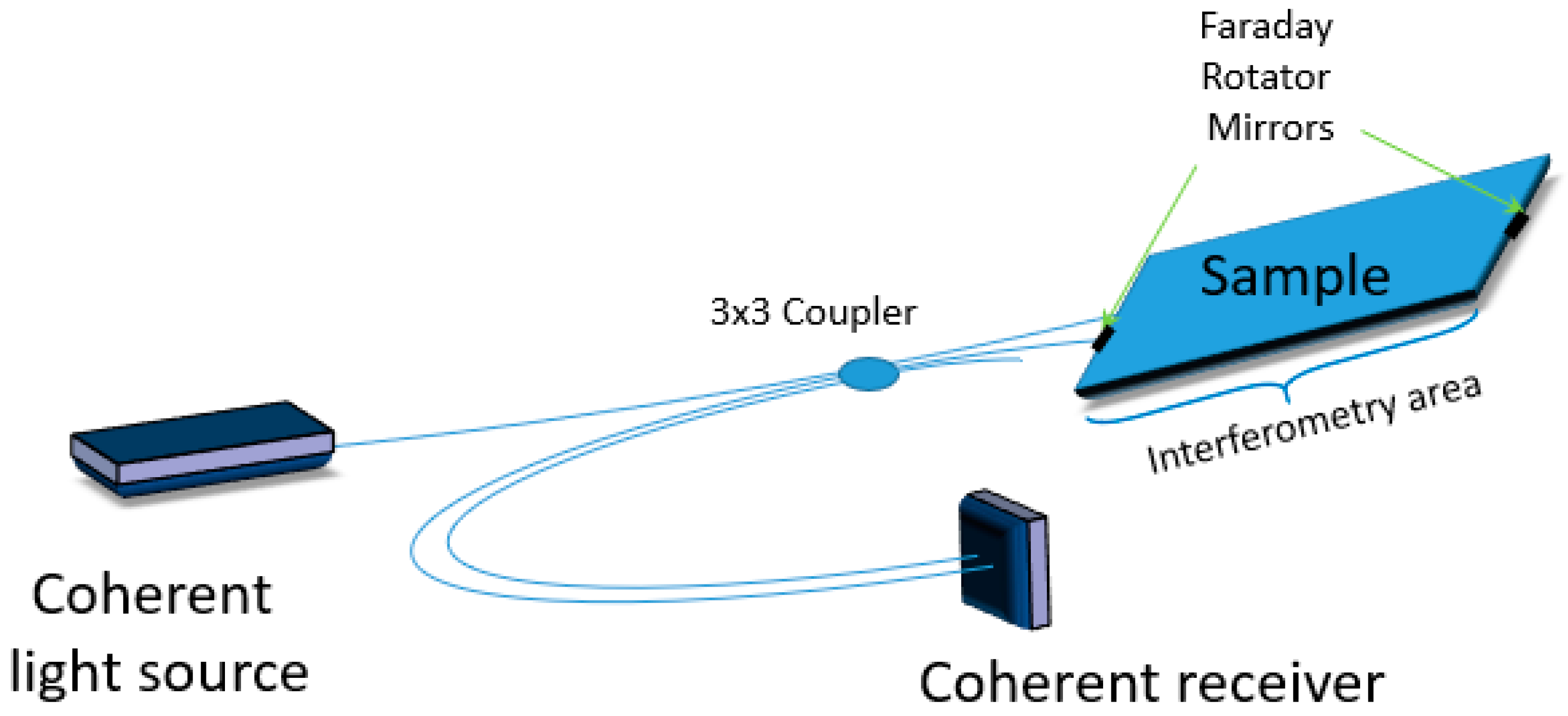
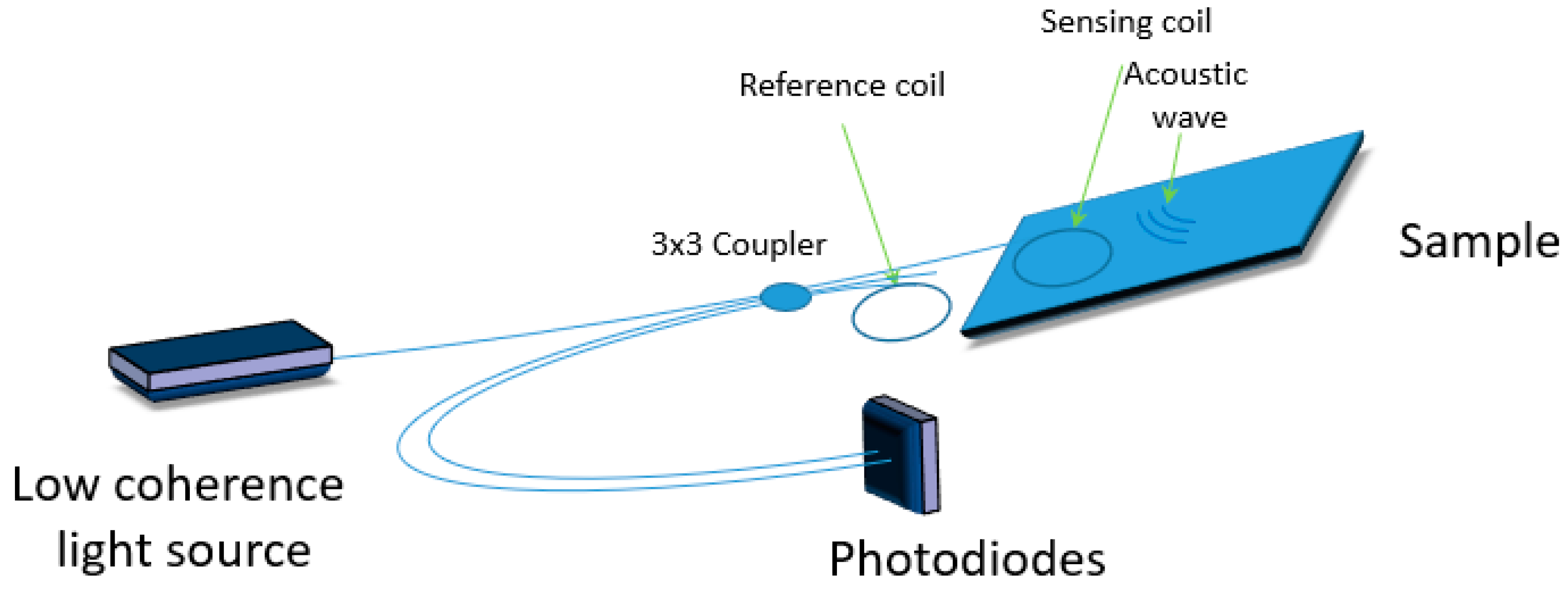
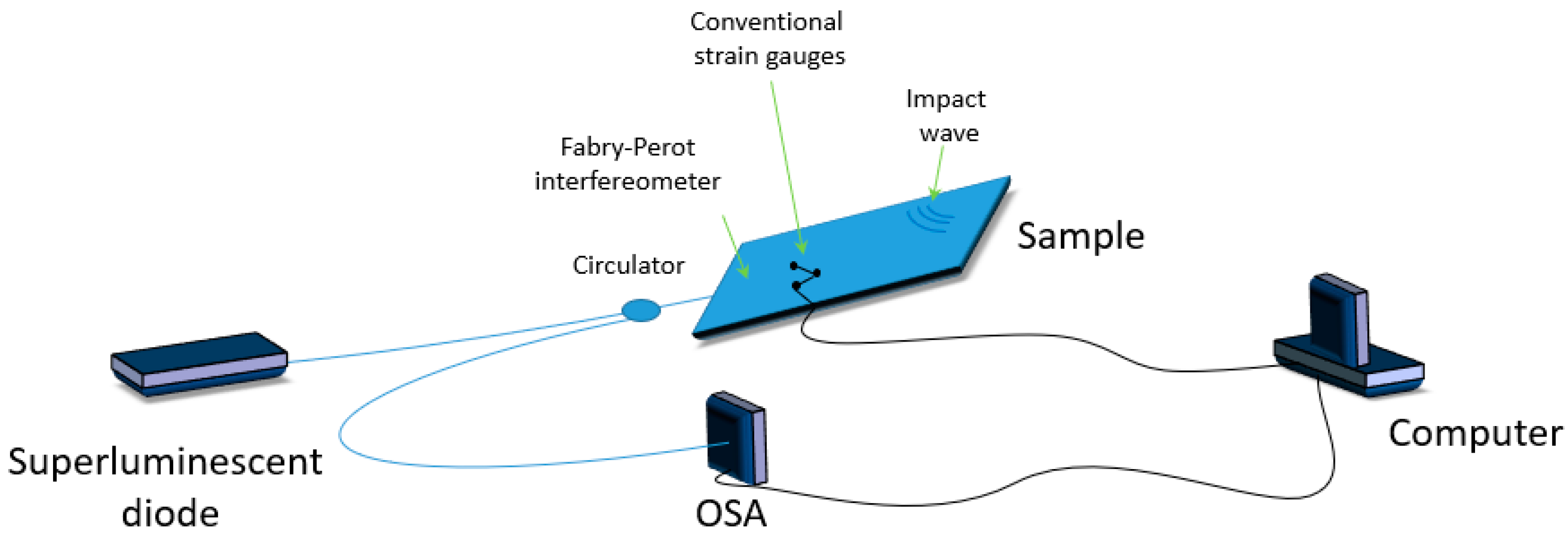
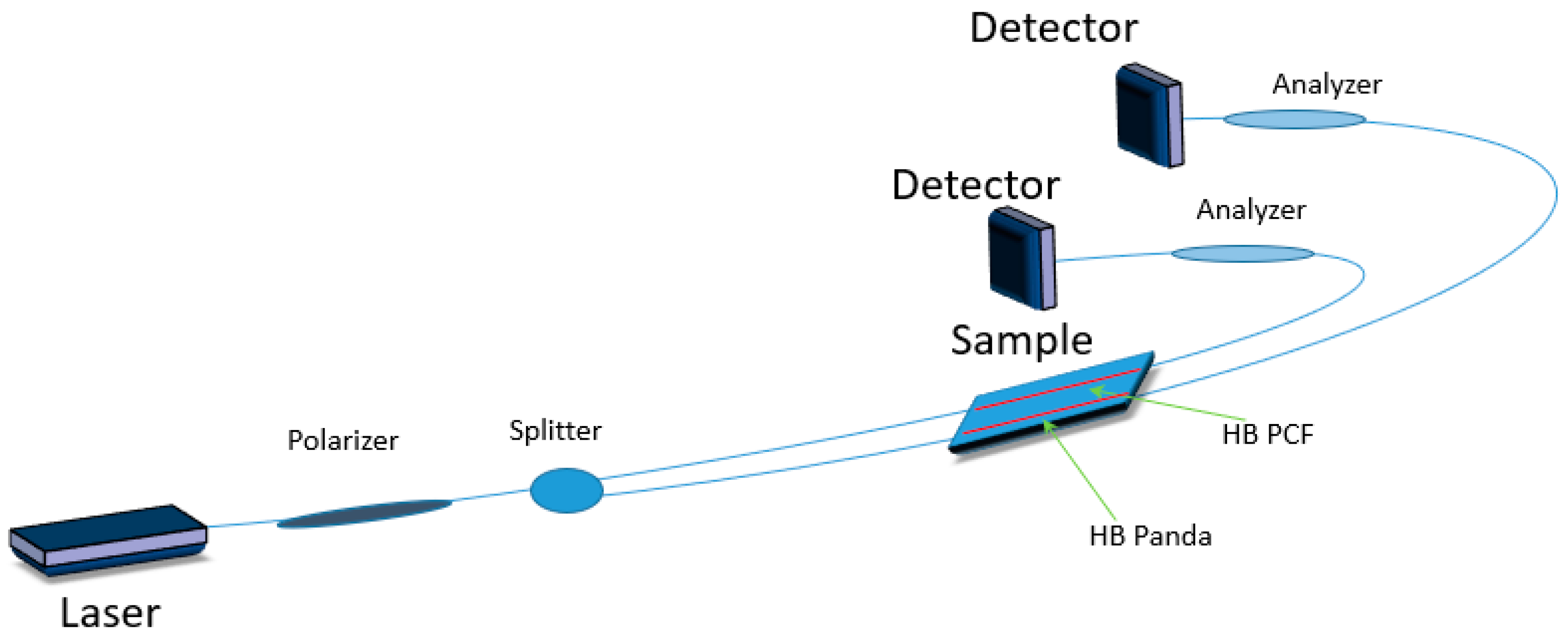
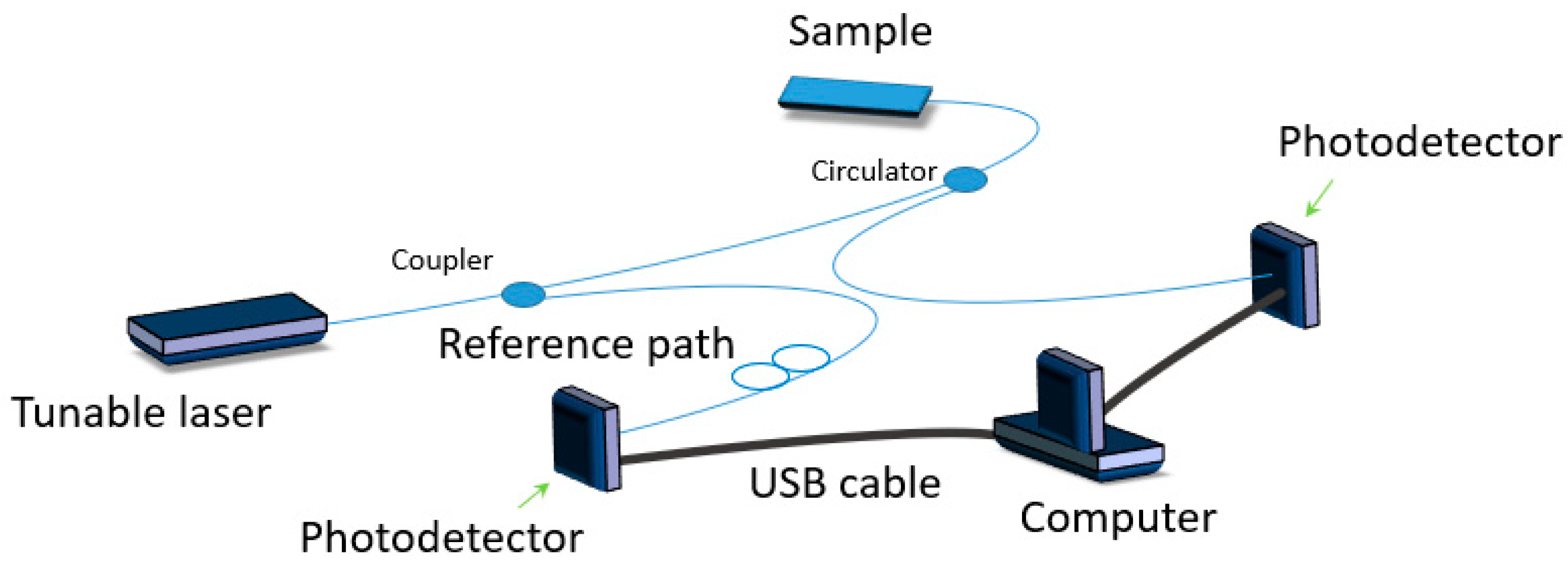
| Ref. | 1 | 2 | 3 | 4 | 5 | 6 | 7 | Mode | Remarks | |
|---|---|---|---|---|---|---|---|---|---|---|
| FBG based | 19 | + | + | + | + | + | + | + | Strain + temperature (static mode) | Strain sensitivity 0.0012 dB/με, temperature sensitivity 0.0039 dB/°C |
| 20 | + | + | + | + | + | + | + | Temperature, strain (transversal + axial) (static mode) | Axial strain sensitivity 1.12 pm/me, transversal strain sensitivity 0.26 pm/mε, temperature sensitivity −0.42 pm/°C | |
| 21 | + | + | + | + | + | + | + | Temperature + strain (static mode) | Strain sensitivity up to 1.22 pm/mε, temperature sensitivity 4.41 pm/°C | |
| 23 | + | + | + | + | + | + | + | Temperature + strain (dynamic and static mode) | Dynamic loads up to 10 Hz, strain sensitivity 7.87 mm−1, temperature sensitivity 6.14 °C−1 | |
| 24 | − | + | + | + | + | + | + | Temperature + strain (static mode) | Strain accuracy 5 mε, temperature accuracy 0.5 °C | |
| 25 | + | − | − | + | − | − | + | Temperature + strain (static mode) | Strain accuracy 20 mε, temperature accuracy 11 °C | |
| 26 | + | − | + | + | + | − | + | Temperature + strain (static mode) | Strain sensitivity 47.68 mε/nm, temperature sensitivity 97.13 °C/nm | |
| 31 | − | − | − | + | + | − | − | Damage detection (dynamic mode) | Detection up to 300 kHz of the acoustic wave, damage localization up to 50 mm from the sensor | |
| 32 | − | − | − | + | + | − | − | Damage detection (dynamic mode) | Detection up to 2 kHz of the acoustic wave | |
| 33 | − | − | − | + | + | − | − | Damage detection (dynamic mode) | Detection up to 100 MHz of the acoustic wave | |
| 34 | − | − | − | + | + | − | − | Damage detection (dynamic mode) | Detection up to 1.3 MHz of the acoustic wave, | |
| 35 | − | − | − | + | + | − | − | Damage detection, localization, (dynamic mode) | Detection up to 1 MHz of the acoustic wave | |
| 36 | − | − | − | + | + | − | − | Damage detection + localization (dynamic mode) | Detection up to 400 kHz of the acoustic wave, damage localization up to 25 mm from the sensor | |
| 38 | + | + | + | + | + | + | + | Bidirectional, Lamb wave (dynamic mode) | Frequency range up to 140 kHz | |
| 39 | + | + | + | + | + | + | + | Multicore, vibration + strain + temperature (dynamic and static mode) | Temperature sensitivity 19.2 pm/°C, strain sensitivity 1.2 pm/m | |
| Interferometric techniques | 40 | + | − | − | + | + | − | + | Strain (dynamic mode) | Reference line, frequency range up to 1.5 kHz |
| 41 | + | − | − | + | + | − | + | Damage detection (dynamic mode) | Reference line, frequency range up to 200 kHz | |
| 42 | + | − | − | + | + | − | + | Damage detection (dynamic mode) | Reference line, frequency range up to 300 kHz | |
| 43 | + | − | − | + | + | − | + | Damage detection (strain) (dynamic mode) | Frequency range up to 500 MHz | |
| HB based | 46 | + | + | + | + | + | + | + | Strain, temperature (static mode) | Strain sensitivity is equal to 4 rad/m*mε |
| Scattering techniques | 57 | + | + | + | + | + | + | + | Temperature + strain (static mode) | Strain (temperature) resolution of 100 με (1.2 °C) at 25 km distance |
| 58 | + | + | + | + | + | + | + | Vibration, strain, temperature (dynamic mode) | Detection up to 4.8 kHz of the vibrations, strain coefficient 0.0495 MHz/με, temperature coefficient ~0.9876 MHz/°C | |
| 59 | + | + | − | + | + | + | + | Temperature + strain (static mode) | Reference line, strain resolution 80 mε, temperature resolution 3.4 °C, | |
| 60 | + | + | + | + | + | + | + | Vibration + temperature (dynamic mode) | Frequency range up to 500 Hz, temperature sensitivity 0.5 °C, spatial resolution—5 m | |
| 61 | + | + | + | + | + | + | + | Vibration, temperature (dynamic mode) | Frequency range up to 500 Hz, temperature sensitivity 0.5 °C, spatial resolution—5 m | |
| 62 | − | + | + | + | + | + | − | Strain, temperature (static mode) | Strain coefficient Brillouin scattering C1 = 5.077 × 10−5 GHz/μɛ and Rayleigh scattering, D1 = −1.477 × 10−1 GHz/μɛ; temperature coefficient of Brillouin scatterings C2 = 1.090 × 10−3 GHz/°C and Rayleigh scattering, D2 = −1.498 GHz/°C. | |
| 63 | + | + | − | + | + | + | + | Strain (static mode) | Reference line, 1 mm spatial strain resolution |
© 2020 by the authors. Licensee MDPI, Basel, Switzerland. This article is an open access article distributed under the terms and conditions of the Creative Commons Attribution (CC BY) license (http://creativecommons.org/licenses/by/4.0/).
Share and Cite
Bednarska, K.; Sobotka, P.; Woliński, T.R.; Zakręcka, O.; Pomianek, W.; Nocoń, A.; Lesiak, P. Hybrid Fiber Optic Sensor Systems in Structural Health Monitoring in Aircraft Structures. Materials 2020, 13, 2249. https://doi.org/10.3390/ma13102249
Bednarska K, Sobotka P, Woliński TR, Zakręcka O, Pomianek W, Nocoń A, Lesiak P. Hybrid Fiber Optic Sensor Systems in Structural Health Monitoring in Aircraft Structures. Materials. 2020; 13(10):2249. https://doi.org/10.3390/ma13102249
Chicago/Turabian StyleBednarska, Karolina, Piotr Sobotka, Tomasz Ryszard Woliński, Oliwia Zakręcka, Wiktor Pomianek, Agnieszka Nocoń, and Piotr Lesiak. 2020. "Hybrid Fiber Optic Sensor Systems in Structural Health Monitoring in Aircraft Structures" Materials 13, no. 10: 2249. https://doi.org/10.3390/ma13102249
APA StyleBednarska, K., Sobotka, P., Woliński, T. R., Zakręcka, O., Pomianek, W., Nocoń, A., & Lesiak, P. (2020). Hybrid Fiber Optic Sensor Systems in Structural Health Monitoring in Aircraft Structures. Materials, 13(10), 2249. https://doi.org/10.3390/ma13102249







